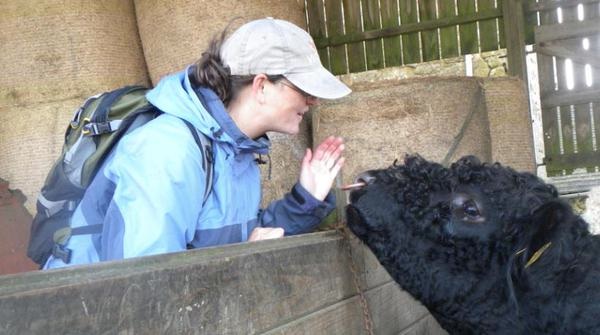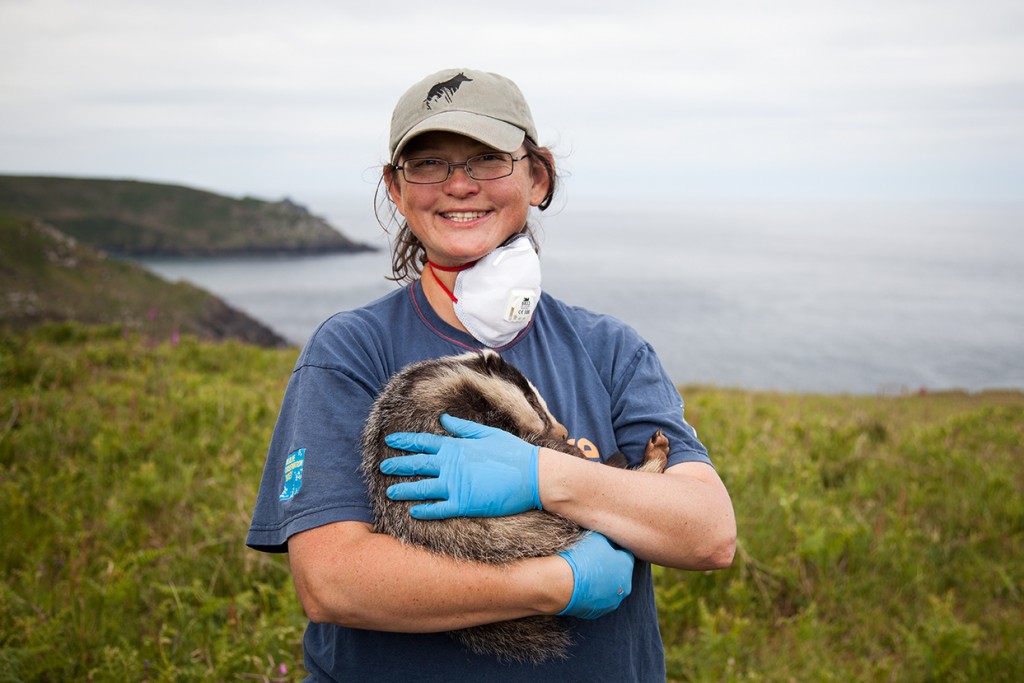Culling badgers to control cattle tuberculosis – a black and white issue?
By Rosie Woodroffe, Institute of Zoology
Last month, the Zoological Society of London together with the British Ecological Society organised a one day symposium, entitled “ The Conservation Science Policy/Interface: Challenges and Opportunities”. Acting as the launch event for the BES’s revitalised Conservation Special Interest Group, the symposium brought together over 150 scientists, conservationists and policy-makers to explore how the links between science and policy can be strengthened. Among the speakers was Prof Rosie Woodroffe, who provided an overview of her experience of the science and politics of the badger cull controversy. This blog post is an account of the talk she gave at this event.

Bovine tuberculosis (TB) is a terrible problem for UK farmers, and the government’s response to it had the potential to become a model for evidence-based policymaking. In 1998, faced with rising cattle TB levels, strong evidence that wild badgers were involved in maintaining the infection, but little confidence that 25 years of badger culling had helped to protect cattle, the government took decisive action to improve its evidence base: it established a randomised controlled trial to explore how two forms of badger culling influenced cattle TB. The Randomised Badger Culling Trial (RBCT) was implemented by government staff and overseen by a small committee of independent scientists (the Independent Scientific Group on Cattle TB, or ISG, of which I was a member). Seventeen years later the RBCT is long since completed, and its clear and consistent results are published in top-quality scientific journals. Yet “badger” has become a byword for entrenched controversy, and a thoroughly evidence-based policy to control cattle TB continues to elude government.
To understand why the RBCT provoked controversy rather than resolving it, one must understand not only what it showed, but also how this information emerged. So, rather than outline the scientific evidence in a convincing logical sequence, I’ll relay the narrative as it unfolded, messily, over time.
Like most good experiments, the RBCT was blinded. In the early stages of experiments when sample sizes are small, trends may be apparent which are far from significant and which disappear when further data are collected. We feared that misinterpretation of such trends might lead to actions which confounded the experimental treatments, such as landowners withdrawing from the trial or culling badgers illegally. Of course it was not possible to hide from farmers whether or not culling was occurring on their land, but the key outcome data – the rates of cattle TB in the trial areas – were accessed only by the government analyst who collated them, two statisticians on the ISG, and an independent auditor. We established a protocol in which interim analyses would be conducted every six months, but the results would be communicated to other ISG members, Ministers, and Defra officials only when a statistically significant result emerged.
It took five years for the first result to emerge. After the long wait, the result was a huge shock to Defra staff: localised badger culling was associated with increases in cattle TB rather than reductions. Trial areas where badgers had been culled locally on and around TB-affected farms (the “reactive treatment”) experienced cattle TB rates significantly higher than those in the areas with no culling (the “survey-only treatment”).
Many Defra officials found it extremely difficult to believe that a form of culling very similar to that used as policy for decades could actually make cattle TB worse rather than better, especially because, at that point, there was little firm evidence to show why reactive culling appeared harmful. They suggested alternative explanations: maybe farmers had been illegally killing badgers in the survey-only areas, controlling TB more effectively than the “official” culls? Maybe our randomisation had accidentally allocated the most TB-affected areas to the reactive treatment?
Despite the uncertainty, Ministers had to act quickly: within days of the ISG discovering the apparently harmful effects of reactive culling, Ministers instructed that this treatment be immediately halted. Traps placed on farms were removed without ever catching a badger. Many Defra officials were uncomfortable with this decision; as one senior advisor complained to me “It depends whether you want to base your policy on a sound veterinary opinion, or just on statistics”.
Over subsequent years, the evidence strengthened. The idea that illegal killing had reduced cattle TB in the survey-only areas was disproved when surveys confirmed that badger activity had declined in the culled areas but not in the unculled areas. The suggestion that the reactive culling areas had higher TB rates by chance was undermined when the treatment was stopped and the harmful effects disappeared. Better still, ecological studies revealed a mechanism whereby badger culling could increase cattle TB. Culling disrupted badgers’ territorial behaviour, giving them opportunities to interact more with other badgers, and with more cattle herds. After culling there were fewer badgers, but each badger was more infectious to cattle because it was more likely to be infected and ranged across more farms.
Despite this growing evidence base, many Defra staff remained deeply suspicious of the RBCT. The reactive treatment had been halted, but the other treatment – large-scale “proactive” culling – continued. The outcomes of proactive culling remained blind for a further three years, while mistrust simmered. A view emerged within Defra that the RBCT would never yield useful results, and that TB control policy would have to advance without it.
As it turned out, there were more surprises to come. Just weeks before the very last scheduled cull, the RBCT threw up new findings. The proactive treatment had reduced cattle TB inside the culled areas. But, completely unexpectedly, TB rates had increased on adjoining unculled land. Once again, these adverse effects appeared to be caused by changes in badgers’ behaviour.
The RBCT was designed to give policymakers a clear way forward; instead it gave them a headache. We had shown conclusively that badgers gave TB to cattle, and that killing large numbers of them could gradually reduce cattle TB inside the culled areas. But while a disease eradication strategy would normally seek to contain infection within a shrinking area, badger culling spread disease to neighbouring land. Worse still, any net benefits depended upon killing a very high proportion of the badger population, very rapidly, across very large areas, repeatedly over several years. Culling which was inefficient, slow, small-scale or unsustained – whether by accident or design – risked worsening the problem it was intended to solve. Given these risks, together with the challenges of delivering affordable culling and the modest benefits even inside the culled areas, we concluded that “badger culling can make no meaningful contribution to cattle TB control in Britain”.
Faced with this uncompromising conclusion, the Minister sought a second opinion. He asked the government’s chief science adviser to evaluate our findings. The chief scientist agreed that badger culling could yield benefits but – having been briefed by Defra staff still smarting from the reactive findings – dismissed our finding of simultaneous harmful effects as “unsound”. His report, which was prepared after a rather cursory reading of our reports and was riddled with errors, was described by Nature as “an example to governments of how not to deal with [scientific] advice”. Nevertheless, Defra now faced a new challenge to evidence-based policymaking: disagreement between scientists.
Since the ISG was disbanded in 2007, other advisory groups have come and gone. Over time the contribution of independent scientists has declined, with greater inputs from vets and farming representatives. Two further culls went ahead in 2013, but when an independent panel deemed them ineffective and possibly inhumane, it was not reappointed. The 2014 culls had no independent oversight, and subsequent claims of success are based on extremely shaky data. Outside government, views have become entrenched and cherry picking evidence has become a cottage industry for both sides of the debate.
If I have learned one thing from living through this science-policy soap opera, it’s this: policymakers and scientists are all just people. People don’t like secrets, and if you’re unaccustomed to experimental design, blinding looks a lot like secrecy. People take time to adjust their views, and new evidence can be hard to accept if it challenges long-held assumptions. Most people prefer to understand before they act: halting the reactive treatment required the Minister to take a leap of faith in science, which was later affirmed by further evidence but hard for his advisors to accept at the time.
How could these problems have been avoided? Perhaps a senior official should have had access to the interim results, to prepare Defra for any emerging findings? But if they had, how could the results have then remained blind to the Minister, to the rest of the ISG, or the public? Would the RBCT have run its course had its interim results been known? More broadly, how could the ISG have helped more Defra staff to feel ownership of the RBCT, while also retaining its own independence? These are difficult problems, hard to resolve even in hindsight. But the truth is, we never seriously expected culling to be so harmful, and so we never expected that our findings would be so hard for Defra to accept.
That the RBCT happened at all is a real credit to Defra. Over the years the RBCT findings have gradually been accepted, and have had a major influence on current policy. The ISG’s caution about the challenges of delivering effective culls has been borne out by recent experience, and over time its conclusions may prevail. In the meantime, similar future endeavours (and I hope there will be many) may benefit from planning for the unexpected. Ecological systems are complex; this was not the first experiment to yield surprising results, and it won’t be the last. Time invested in building mutual understanding and trust between independent scientists and government will not be wasted; and if the findings are surprising next time, perhaps they will be easier to accept.
Rosie Woodroffe is a field ecologist at ZSL, equally fond of badgers and cattle

The views expressed in posts on this blog are personal to the author and are not necessarily shared by any sponsors or owners of this blog or any other person or entity involved in creating, producing or delivering it and no such party shall be held liable for any statements made or content posted.
This post from Rosie Woodroffe is also available on the The Applied Ecologist’s blog and the ZSL Wild Science blog.
For media enquiries about this blog post, please contact the BES Press Officer
Like what we stand for?
Support our mission and help develop the next generation of ecologists by donating to the British Ecological Society.